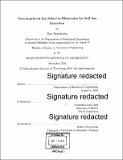Screen-printed ion selective electrodes for soil ion detection
Author(s)
Rosenberg, Ron, S.M. Massachusetts Institute of Technology
DownloadFull printable version (19.76Mb)
Other Contributors
Massachusetts Institute of Technology. Department of Mechanical Engineering.
Advisor
Anastasios John Hart.
Terms of use
Metadata
Show full item recordAbstract
Rural Indian farmers lack an available, affordable, usable, and actionable means to diagnose soil health, which is a prerequisite for judicious application of fertilizer. Although government labs and mobile kits are available, these fail to meet the aforementioned qualities; as a result fewer than 5% of rural Indian farmers have ever performed a soil test. This thesis details the design and characterization of a point-of- use soil testing device, comprising a set of disposable ion-selective electrode (ISE) strips and a handheld electrochemical reader, which together transduce soil analyte concentrations into a numeric input for a mobile-phone based fertilizer recommendation engine. As a proof-of-concept, potassium (K+) selective electrodes are studied, because K+ is essential to plant growth and reproduction. The strips employ a simple two electrode system, wherein carbon nanotube and silver chloride inks are the electrode contacts, plasticizer-free butyl acrylate ion selective membranes are located on the working electrodes, and sodium-chloride doped polyvinyl butyral membranes provide stable reference potentials. The electrodes were fabricated by a combined screen printing and drop casting process, and the protocol, extraction solution, and reference potential stability were tuned to maximize ISE performance and repeatability. Using a mathematical model and supporting experiments, we verified that hydrogen selectivity determines the detection limit, and furthermore, that scientists can tune the ionophore-ionic site ratio to minimize this effect. Using the final electrode fabrication process, a set of 20 full ISE devices in the presence of 0.02M SrCl2 extraction solution were shown to have sub-uM detection limits and near-Nernstian average sensitivity (61 mV/decade). When compared to ICP data for a set of 30 soil samples using the final reader, the sensors demonstrated a 0.898 correlation factor. Workshops in India were conducted to determine user needs and corresponding product attributes, as well as a "usability index" for the system assessed across farmer demographics. The favorable system performance proves that solid-state ISEs are a promising technology for soil diagnostics in resource-constrained environments.
Description
Thesis: S.M., Massachusetts Institute of Technology, Department of Mechanical Engineering, 2016. Cataloged from PDF version of thesis. Includes bibliographical references (pages 187-192).
Date issued
2016Department
Massachusetts Institute of Technology. Department of Mechanical EngineeringPublisher
Massachusetts Institute of Technology
Keywords
Mechanical Engineering.